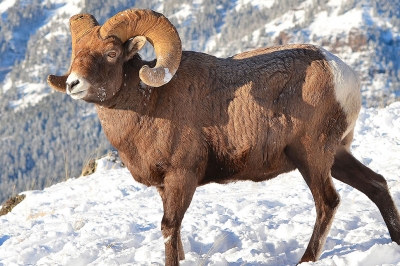Oregon Department of Fish and Wildlife and the Confederated Tribes of the Umatilla Indian Reservation have determined that the same strain of bacterial pneumonia that caused a die-off in the Lookout Mountain bighorn sheep herd earlier in the year has spread to the Burnt River herd.
This year is the first-time bacterial pneumonia (caused by the organism Mycoplasma ovipneumoniae) has been identified in the Burnt River herd. While I-84 normally separates the herds, bighorn sheep have been known to try to cross the highway. The Lookout Mountain herd ranges north of I-84 and west of Brownlee Reservoir, about 10 miles from the Burnt River Canyon herd, which is south of I-84.
ODFW and CTUIR collected samples for disease testing (nasal swabs) from a tribally hunter-harvested 4.5 year-old ram and another young ram found dead in Burnt River Canyon. Tests results show the bacterial strain in these animals closely matches the Lookout Mountain strain and is unique from strains isolated from neighboring Hells Canyon herds. This information paired with the timing of the outbreak and documentation of sheep trying to cross I-84 suggests likely transmission between these two herds.
So far, ODFW has collected three dead sheep from the Burnt River herd. A very sick lamb was also put down and another sick lamb was observed near one of the dead ewes collected (likely her offspring). All of these sheep were confirmed to have bacterial pneumonia.
The Lookout Mountain bighorn sheep herd pneumonia outbreak was discovered in February 2020 and resulted in the cancellation of all once-in-a-lifetime sheep hunts in the unit this year. All lambs in the Lookout Mountain herd have perished due to this outbreak but adult mortality appears to have tapered off during the summer months as expected.
Sheep will congregate at lower elevations during the late fall and winter period, increasing the risk of disease transmission between individuals. Currently ODFW is testing and monitoring the Lookout Mountain and Burnt River herds to determine the extent of the mortality and the current infection rate in the remaining population
Pneumonia has killed numerous wild sheep in Oregon and other Western states over the past few decades and is considered the largest risk to wild sheep populations. Once a herd is infected, an all-age die off can occur and the disease may remain chronic in the population.
Disease treatment in free-ranging populations of sheep is not practical. Wildlife managers strive to keep wild and domestic sheep and goats separate to avoid transmission of the disease.
Bighorn sheep with pneumonia may exhibit signs including coughing, nasal discharge, and difficulty climbing or running.

